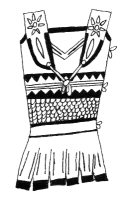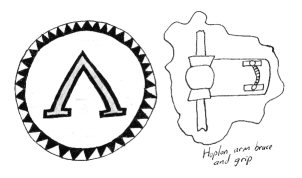The Persian Empire is the generic term for the territory controlled by the inhabitants of modern Iran during the period of 559 to 330 BC. The actual historical name is the Achaemenid Empire after the clan of rulers who controlled it. Shah-an-Shah was the title Darius I gave to himself, meaning King-of-Kings. Controlling one the largest empire yet seen in the world, the Persian army was one of the first full-time professional armies and was made up of many different peoples, most conscripts from the subjugated nations ruled by the Persian kings. Egyptians, Assyrians, Indians, Scythians, Bactrians, and Ethiopians all fought alongside the more “traditional” Persian forces, specifically made up of men of Persian or Medean descent (these two peoples were native to Iran). Initially each of these forces brought their own cultural weapons, but over time the forces and weapons mixed, so when Alexander the Great attacked the Persian Empire in the 4th century BC he faced a far more uniform opponent than the Greeks did in the 5th century.
This is not to say that by the end of the Achaemenid Empire that their troops were identically equipped, rather that over time their weapons and armor had merged and been shared, giving a more uniform appearance than before. Specifically, this article will examine what are considered “traditional” Persian weapons. Spears were the main weapons of the infantry, swords being a rarity, while archers were armed with a powerful recurved bow. Cavalry and missile troops (such as archers, slingers, and javelin throwers) made up the bulk of the Persian army, forcing a dependency on agility and speed over armor and defense. As a result Persian troops suffered greatly at the hands of Hellenistic phalanxes, since they neither had the armor or weapons to attack a Greek hoplite one-on-one. The Persians were almost always able to field a larger force than their opponents in most cases, due to local levies. Due to the feudalistic form of government, Persian troops were forced to supply their own weapons and equipment: resulting in a well-equipped cavalry force made up of the richer citizens and cheaply armed poorer infantry.
Armor and Helmets – Armor was not very widespread among Persian troops, worn mainly by wealthier members of the army, namely the cavalry and the Immortals. One form of armor not described here was quilted linen armor, similar to the armor worn by Iphikratean hoplites and soldiers like Alexander the Great. As with armor, helmets were scarce in the infantry, but quite common in the cavalry, especially horsemen of the later Achaemenid Empire.
Scale
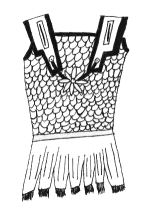
Scale armor has an ancient tradition in the east and the Persians were no exception. It was often made of small bronze plates sewn together on a leather shirt, although iron and sometimes gold were also used. Infantrymen who could afford to buy such a costly piece of armor sometimes wore it under their clothing. Later Achaemenid cavalry wore elaborate scale hauberks, complete with chaps made of the same material. The image above is a late Achaemenid hauberk which shows heavy Greek influence.
Linothorax
Greek armor made a great impression upon the Persians, since the vast difference in protection between the opposing armies during the Persian Wars had been in part a reason for the Achaemenid defeat on a tactical level. By the late 5th and early 4th century BC, some Persian soldiers were equipped with the Greeklinothorax, a cuirass made up of glued layers of linen. As with most pieces of armor, the linothorax was worn mainly by the cavalry, who were made up of the social elite.
Helmets
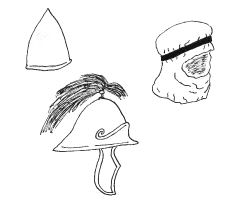
Helmets were rare in the Persian army, although later Achaemenid cavalry were well protected by bronze helmets. Instead of helmets most soldiers wore a cloth headgear known as a tiara, which featured a scarf that could be pulled over the face. In the early Persian Empire helmets were worn by a small number of soldiers, and even then only by those who were rich enough to buy one. Early helmets were typical eastern conical helmets, made of bronze, while later helmets were highly influenced by the Greeks. Typically helmets were worn by the cavalry, who were the only soldiers who could afford to buy them.
Shields – As with most armies in the ancient world, the Persian troops fielded shields, but unlike other soldiers Persian troops were far more reliant on their shields for protection than others. Since armor and helmets were fairly rare, shields were usually the only piece of defensive equipment that a Persian soldier would possess. Unfortunately traditional Persian shields were rarely up to the task, being made of whicker and leather.
Spara
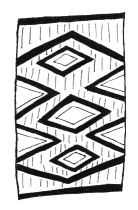
These were large rectangular shields made of reed or whicker, covered with leather and were often elaborately painted. In battle a row of infantry known as sparabara would advance in front of missile troops such as javelin throwers or archers. They would lock the roughly 5-foot spara together, forming a wall behind which the archers could fire safe from enemy cavalry and heavy infantry, while the sparabara engaged the enemy with spears. Spara disappeared from the ranks in the early 4th century BC.
Gerron
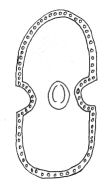
The traditional shield of Persian infantry, the gerron was a figure eight shaped shield made of whicker covered with leather. In combat the soldier held the shield by a vertical grip in between the crescent-shaped concave indentations of the gerron. Unfortunately for Persian troops the light construction of the gerron did not stop heavy weapons like spears from puncturing the relatively flimsy whicker. Although it continued to be used later on during the Empire the gerron was often discarded in favor of a hoplon-style shield.
Hoplon-Style Shield
Greek equipment was wide spread in the Persian army by the time of Alexander the Great, including hoplon-style shields. This was due mainly to the poor quality of the traditional gerron in battle, the bronze covering of the hoplon proving far more effective at stopping blows than wicker. They were copies of the Greek originals, made of bronze and wood, roughly 3 feet in diameter. As with the Greeks, Persian infantry were the users of the heavy shield.
Crescent
Pelta-like shields were used by Persian peltasts and other light troops in the later Persian Empire, probably due to Greek influence. As with Hellenistic peltasts, the crescent shield gave light troops good protection without sacrificing speed and mobility. Like other Persian shields, crescent shields could be elaborately painted (although the reconstruction shows traditional Thracian designs).
Weapons – The Persians relied heavily on missile troops and cavalry in battle, equipped with javelins and recurved bows. Slingers were also employed by the Persians although in relatively small numbers when compared with archers. Infantry used spears as their main weapons, swords being reserved for the more elite units. In the Late Achaemenid Empire swords became more common as Greek equipment spread throughout the army.
Thrusting Spear

Persian soldiers used a fairly short thrusting spear as their main weapon. Roughly 7 feet long, they were equipped with a broad iron spearhead and counterbalanced by a round metal counterweight. In more elite units the counterweight was silver for soldiers, their officers being equipped with golden ones while bronze counterweights were more common in the rank and file of the Persian army. As a result of these metal counterweights Persian troops were known as “apple-bearers”. In addition to the short spear, the Persians also fielded pikes of roughly 10 feet.
Palta
Cavalry and missile troops made up the bulk of the Persian army, many of these troops being equipped with these light javelins. They were roughly 4 feet long, with throwing straps to increase the range and power of the weapon when the iron spearhead struck an enemy. Horsemen used a pair of palta as their main offensive weapons, reserving their swords for defense. According to some ancient texts, one javelin was used to throw, while the other was kept for close combat if necessary. In many cases though, the palta would be tossed away and a bladed weapon would be used once hand-to-hand combat began. Light infantry were equipped with javelins as well, often carrying a sagaris for close combat.
Akinakes

Originally developed by the Scythians, the early Achaemenid Persians adopted the akinakes as their main sword in combat. Roughly 20 inches long (give or take a few inches), the akinakes was worn on the right hip, near the soldier’s fighting hand. The iron blade could be used for either cutting or stabbing, being double edged. Elite troops such as the famous Persian Immortals, or Amrtaka, were the main users of the akinakes, common soldiers being too poor afford swords. Persian soldier’s began using the weapon in the 7th century BC until it finally disappeared from history in the 2nd century BC.
Xiphos
In the 4th century BC Greek arms and equipment were state of the art and the Persians (like many armies) adopted Greek equipment, including the straight Greek xiphos. Since the Persian Wars in the early 5th century, the Persians had suffered many defeats at the hands of the Greeks and logically it was thought that equipping oneself like the enemy would aid in battle against that enemy. Infantry and cavalry of the late Achaemenid Empire carried the xiphos, which was used by the cavalry mainly for defense once they had thrown their javelins.
Kopis
The kopis was not limited just to the Greeks, but was utilized by the Persians as well. Infantry and cavalry carried this heavy slashing sword.
Akinaka
Most Persian infantry did not carry swords, rather large daggers, which they carried on their right side, like theakinakes. They could be used in full hand-to-hand combat like a sword or used to kill wounded opponents on a battlefield. Akinaka were in the 10 to 14 inch range.
Bow
The bow was the core weapon of the Persian army, most of the infantry being armed with a powerful recurved bow similar to the similar Scythian weapon. Recurved bows gained their power by bending the bow opposite to the natural curve of the weapon, creating added tension and force. In battle the large numbers of Persian archers would fire in massive barrages, sending sheets of arrows down on their opponents. Unfortunately, despite the power of their bow, the Persian arrows were extremely light, made of cane and tipped with a three-flanged bronze arrowhead. Due to the lightness of the missile, Persian troops were unable to puncture the heavy armor of Hellenistic soldiers. The recurved bow could be held in a carrying case hung on the back or the left side of a soldier’s belt. In addition the quiver was worn on the hip and allowed for rapid fire, whether on foot or on horseback. The famous Immortals also used the recurved bow, although they carried their quiver on their backs to allow them to close for hand-to-hand combat.
Sagaris

As with the akinakes, the sagaris (light battle axe) was Scythian in origin, having been adopted by some Persians in the early Achaemenid Empire. It featured a relatively slender iron axe head coupled with a long handle with a reverse spike opposite the axe blade. The sagaris could be used one handed and was capable of chopping through heavy bronze armor, one famous instance of this was when Alexander the Great was almost killed by a sagaris-wielding Persian cavalryman. During the Battle of Granicus, Alexander was leading the Companion Cavalry in combat, when a Persian horseman managed to land a blow with his sagaris on the Macedonian’s helmet, splitting it. The blade of the axe actually touched Alexander’s hair, but fortunately for the Macedonian king, a comrade impaled his attacker with a spear, leaving Alexander unscathed. Many Persian cavalrymen used a sagaris in place of sword for close quarter combat.
